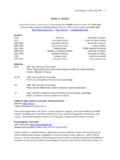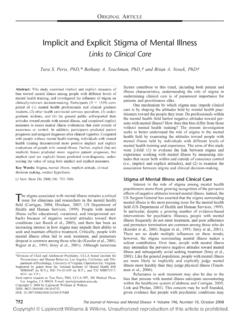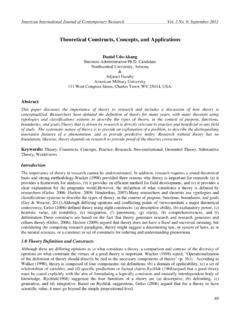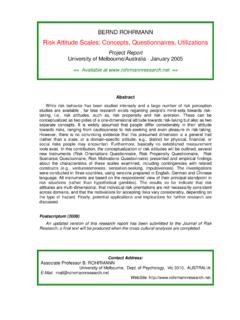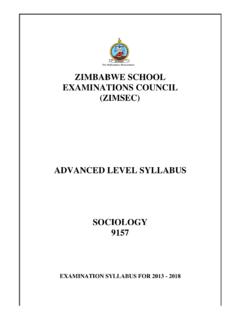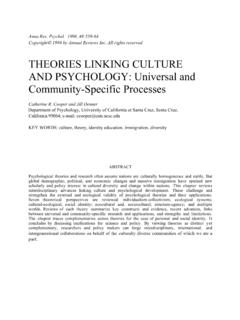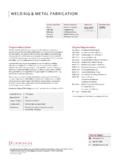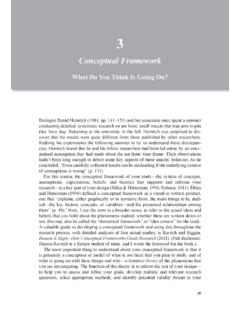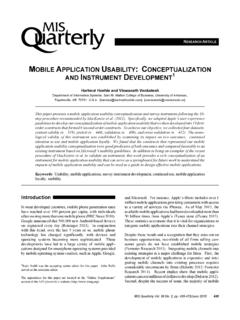Transcription of The Implicit Association Test at Age 7: A …
1 6 The Implicit Association Test atAge 7: A Methodological andConceptual ReviewBRIAN A. NOSEK, ANTHONY G. GREENWALD, andMAHZARIN R. BANAJIA mong earthly organisms, humans have a unique propensity to introspect orlook inward into the contents of their own minds, and to share those obser-vations with others. With the ability to introspect comes the palpable feel-ing of knowing, of being objective or certain, of being mentally in control of one sthoughts, aware of the causes of one s thoughts, feelings, and actions, and ofmaking decisions deliberately and rationally.
2 Among the noteworthy discoveriesof 20th century psychology was a challenge posed to this assumption of the groundbreaking theorizing of Herbert Simon (1955) and the mind-boggling problems posed by Kahneman, Slovik, and Tversky (1982) to strikingdemonstrations of illusions of control (Wegner, 2002), the paucity of introspection(Nisbett and Wilson, 1977), and the automaticity of everyday thought (Bargh,1997), psychologists have shown the frailties of the minds of their psychologists have come to grips with the limits of the mind, there has beenan increased interest in measuring aspects of thinking and feeling that may not beeasily accessed or available to consciousness.
3 Innovations in measurement havebeen undertaken with the purpose of bringing under scrutiny new forms of cogni-tion and emotion that were previously undiscovered and especially by asking iftraditional concepts such as attitude and preference, belief and stereotype, self-concept and self-esteem can be rethought based on what the new measures newer measures do not require introspection on the part of the many constructs this is considered a valuable, if not essential, feature ofmeasurement; for others, avoiding introspection is greeted with suspicion andskepticism.
4 For example, one approach to measuring math ability would be to ask how good are you at math? whereas an alternative approach is to infer mathability via a performance on a math skills test. The former requires introspectionto assess the relevant construct, the latter does not. And yet, the latter is acceptedas a measure of math ability, and is even preferred to one requiring the target construct concerns a preference, stereotype, or identityrather than performance, issues about interpretation turn out to be more complexthan those involving performance, such as on tests of ability (memory, conceptformation) where there is an assumed correct answer.
5 For some, the dismissal ofintrospection as relevant to the assessment of such constructs is difficult. Attitudes,stereotypes, and identity appear to be wound so tightly to subjective thoughtsand feelings that asking seems to be the most persuasive of probes. I knowhow I feel and Don t tell me how I feel are not just expressions in inter-personal communication they are assumed by psychologists who accept such anepistemological the last few years, one measure in particular, the Implicit Association Test(IAT), has spurred discussion among both experts and nonexperts about itsmechanisms, scope, interpretation, and political implications.
6 In this chapter, wereview the main issues that are debated and provide our best assessment of itscurrent CognitionBuilding on the Implicit explicit distinction in memory(Roediger, 1990; Schacter, Bowers, & Booker, 1989), Greenwald and Banajiproposed a general distinction for Implicit cognition. They defined an implicitconstruct as the introspectively unidentified (or inaccurately identified) trace ofpast experience that mediates R where R refers to the category of responses thatare assumed to be influenced by that construct (Greenwald & Banaji, 1995, p.)
7 5).Greenwald and Banaji applied that general definition to social psychology s mostcentral constructs attitudes, stereotypes, and self-esteem. They noted thatimplicit cognition could reveal associative information that people were eitherunwilling or unable to report. In other words, Implicit cognition could revealtraces of past experience that people might explicitly reject because it conflictswith values or beliefs, or might avoid revealing because the expression could havenegative social consequences.
8 Even more likely, Implicit cognition can revealinformation that is not available to introspective access even if people were motiv-ated to retrieve and express it (see Wilson, Lindsey, & Schooler, 2000, for a similartheoretical distinction for the attitude construct specifically). Such information issimply unreachable in the same way that memories are sometimes unreachable,not just in amnesic patients but in every many constructs such as memory, attitudes, stereotypes, self-concept, self-esteem, personality, and knowledge, the Implicit explicit taxonomy has not justhelped to organize existing theory and empirical evidence, but has also broadenedthe construct beyond introspective limits.
9 For example, while few definitions ofattitude mentioned introspective access as a necessary feature, until the 1980sattitude measurement largely proceeded as if the very definition of attitude reliedon an assumption that attitudes were consciously available (Greenwald & Banaji,1995). Implicit MeasurementWhatever the value of the Implicit explicit distinc-SOCIAL PSYCHOLOGY AND THE UNCONSCIOUS266tion, in practice the distinction has been rather loosely applied to organize aheterogeneous set of assumed cognitive mechanisms.
10 The term Implicit has cometo be applied to measurement methods that avoid requiring introspective access,decrease the mental control available to produce the response, reduce the role ofconscious intention, and reduce the role of self-reflective, deliberative next generation of research in Implicit cognition will likely revise the simpleimplicit explicit distinction and introduce a more refined taxonomy that betterreflects the heterogeneity of cognitive processes that are collectively termedimplicit. In this chapter, we do not tackle these issues.
